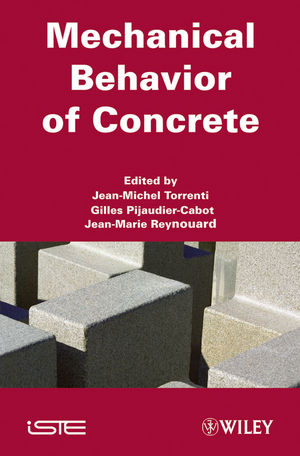Mechanical Behavior of ConcreteISBN: 978-1-84821-178-0
Hardcover
419 pages
April 2010, Wiley-ISTE
 |
||||||
Foreword xi
PART 1. INSTANTANEOUS OR TIME-INDEPENDENT MODELS FOR CONCRETE 1
Chapter 1. Test Techniques and Experimental Characterization
3
Nicolas BURLION
1.1. Introduction 3
1.2. Experimental specificities related to concrete material 4
1.3. Extensometers and experimental conditions 12
1.4. Behavior of concrete under uniaxial stress: classical tests 21
1.5. Concrete under multiaxial stresses 32
1.6. Conclusions regarding the experimental characterization of the multiaxial behavior of concrete 54
1.7. Bibliography 55
Chapter 2. Modeling the Macroscopic Behavior of Concrete
63
Jean-Marie REYNOUARD, Jean-François GEORGIN, Khalil HAIDAR and
Gilles PIJAUDIER-CABOT
2.1. Introduction 63
2.2. The discrete approach 65
2.3. Continuous approach 71
2.4. Conclusion 106
2.5. Bibliography 115
Chapter 3. Failure and Size Effect of Structural Concrete
121
Gilles PIJAUDIER-CABOT and Khalil HAIDAR
3.1. Introduction 121
3.2. Probabilistic structural size effect 124
3.3. Deterministic size effect 130
3.4. Fractality and size effect 134
3.5. Size effect and calibration of non-local models 138
3.6. Conclusions 143
3.7. Acknowledgement 145
3.8. Bibliography 145
PART 2. CONCRETE UNDER CYCLIC AND DYNAMIC LOADING 149
Chapter 4. Cyclic Behavior of Concrete and Reinforced
Concrete 151
Jean-François DUBÉ
4.1. Characterization tests of the cyclic behavior 151
4.2. Modeling the reinforced concrete cyclic behavior 163
4.3. Modeling of the cyclic behavior of concrete 170
4.4. Conclusions 180
4.5. Bibliography 181
Chapter 5. Cyclic and Dynamic Loading Fatigue of Structural
Concrete 185
Jean-François DESTREBECQ
5.1. Introduction 185
5.2. The mechanisms of concrete fatigue 186
5.3. The fatigue strength under uniaxial compression or traction 193
5.4. Extension to Aas-Jakobsen’s formula 197
5.5. Fatigue under multiaxial loading 202
5.6. Fatigue under high-level cyclic loading 207
5.7. Fatigue strength under variable level cyclic loadings 214
5.8. Bibliography 219
Chapter 6. Rate-Dependent Behavior and Modeling for Transient
Analyses 225
Fabrice GATUINGT
6.1. Introduction 225
6.2. Experimental behavior 225
6.3. Behavior modeling of concrete in dynamics 240
6.4. Bibliography 261
PART 3. TIME-DEPENDENT RESPONSE OF CONCRETE 265
Chapter 7. Concrete at an Early Age: the Major Parameters
267
Vincent WALLER and Buqan MIAO
7.1. Introduction 267
7.2. Influence of the composition of concrete 267
7.3. Consequences of boundary conditions 282
7.4. Conclusion 290
7.5. Bibliography 290
Chapter 8. Modeling Concrete at Early Age 297
Franz-Josef ULM, Jean-Michel TORRENTI, Benoît BISSONETTE and
Jacques MARCHAND
8.1. Introduction 297
8.2. The coupled thermo-chemo-mechanical problem 297
8.3. Data collection and experimental methods 309
8.4. Conclusion 331
8.5. Bibliography 331
Chapter 9. Delayed Effects – Creep and Shrinkage
339
Farid BENBOUDJEMA, Fékri MEFTAH, Grégory HEINFLING,
Fabrice LEMAOU and Jean Michel TORRENTI
9.1. Introduction 339
9.2. Definitions and mechanisms 340
9.3. Experimental approach 354
9.4. Delayed response modeling 361
9.5. Codified models 383
9.6. Conclusion 400
9.7. Bibliography 400
Closing Remarks: New Concretes, New Techniques, and Future
Models 409
Jean Michel TORRENTI, Gilles PIJAUDIER-CABOT and Jean-Marie
REYNOUARD
List of Authors 415
Index 417



